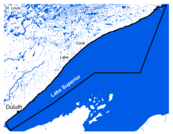Lower Shore: Duluth to Two Harbors
Some warmer days and low winds, made for good fishing conditions on the Lake and there was an increase in angler success throughout the Lower Shore. Surface water temps were in the upper 60’s, in most areas, and as high as 70 °F near the Estuary. Lake Trout fishing was great this week with many folks coming back to the docks with their limit. Running lines at around 150 feet down, in 200+ feet of water did the best, especially using meat rigs and shiny spoons. Jigging for Lake Trout was also quite productive in the Two Harbors area. The best action was in 130-160 feet of water. The northeast winds blew warm water up the shore over the week and as a result, Salmon of all species were sparse.
Upper Shore: Twin Points to Hovland
Surface water temps were 62-65 °F extending as deep as 100 feet down. With such warm water, anglers reported Lake Trout were generally below 100 feet, requiring downriggers, wire line rigs, and vertical jigging techniques to hook up. However, reports of good numbers of Lake Trout in shallow, early in the morning, were received, but as the day went on they steadily moved into deeper water. Anglers caught many Lakers in the 4-12 pound range with some as large as 20 pounds. No reports of Chinook or Coho Salmon were received from any station. Pink Salmon have entered the rivers for the fall spawning run. Fair numbers of anglers have been observed on the Temperance, Baptism, Cascade, and Brule rivers targeting them in the warm, shallow water. Shore anglers reported catching a few Brook Trout from Grand Marais and Taconite Harbor this week.
Management Updates
Anglers have seen an increase in the number of Sea Lamprey and Sea Lamprey wounds on fish caught in Lake Superior this year. The U.S. Fish & Wildlife Service and Fisheries and Oceans Canada are the two Federal agencies tasked with Sea Lamprey assessment and control under the auspices of the Great Lakes Fishery Commission. In 2020, thirty tributaries around Lake Superior were scheduled to be treated to kill larval Sea Lamprey before they become parasitic and feed on fish. However, only 10 of those tributaries were treated due to travel restrictions associated with the COVID-19 pandemic. Unfortunately, this increase in adult Sea Lamprey abundance, increased wounding on Lake Trout, and an increase in the number of fish killed (each Sea Lamprey consumes 40 pounds of fish in its lifetime) was anticipated but should be short-lived. Treatments on Lake Superior tributaries have since resumed and anglers should notice fewer Sea Lamprey and Sea Lamprey wounds on fish over the next few years.
For more information on Sea Lamprey control in the Great Lakes check out the Great Lakes Fishery Commission website and the most recent report Sea Lamprey Control in the Great Lakes 2023 from the U.S. Fish and Wildlife Service and Fisheries and Oceans Canada.
Helpful Links
 Questions?
Visit us online at mndnr.gov
If this message was shared with you, sign up to receive it at the link above.
Email us at Lake Superior fishing report
Give us a call at 218-302-3277
Fishing report hotline at 218-302-3293
Report suspicious activity at 800-652-9093
|